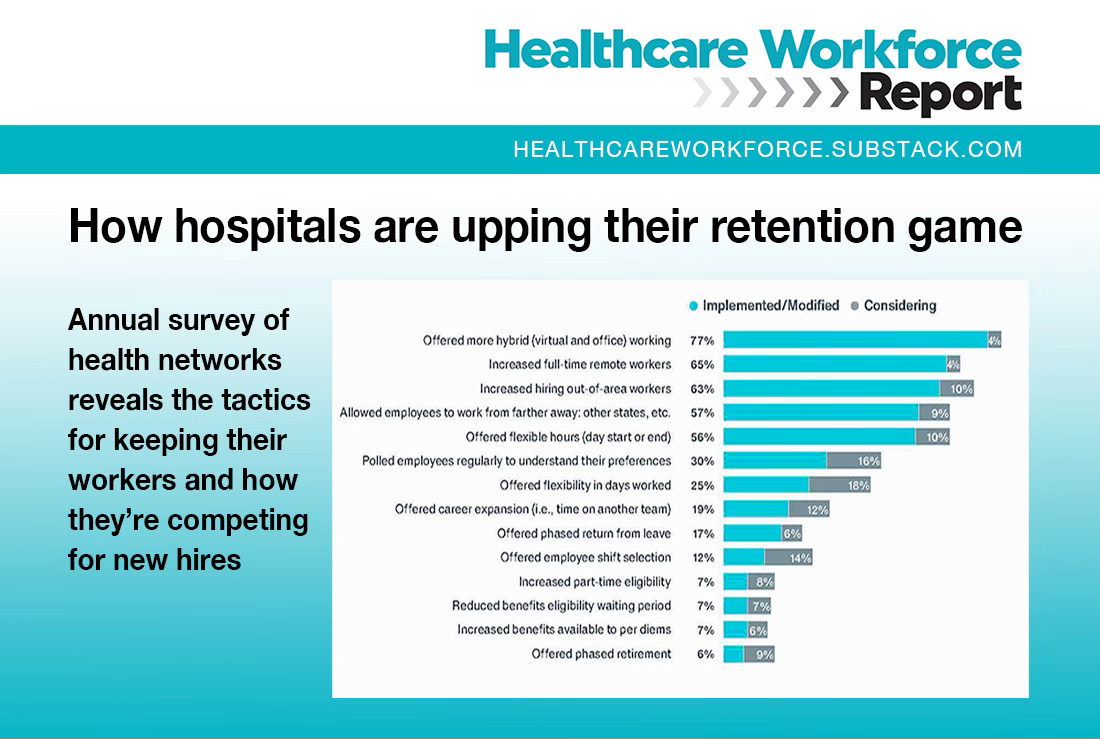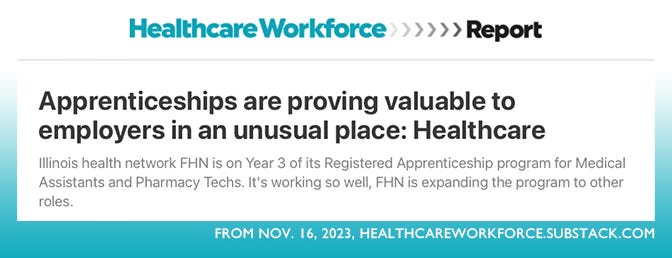Annual predictions you probably haven’t heard every year in recent memory
A "Top 3" list summarizing the best of all those 2024 healthcare workforce trends articles. Plus: A new report says employee wellness "benefits" don't cut it.
If you’re reading this, you’ve probably already seen the December jobs data for healthcare, so I’ll keep this brief: The sector added 38,000 jobs last month; on average, healthcare added 55K jobs per month in 2023, a 20% increase year-over-year.
Another new report showed that layoffs in healthcare nearly doubled in 2023 from the year before — but experts say the industry is stabilizing from the effects of the pandemic on employers, expenses, and staffing.
According to BLS, the healthcare industry (including ambulatory health care services, hospitals, and nursing and residential care facilities) employed 17.24 million people in December, which is close to a record high.
Stay with me, because: Controversial research calls out employers, kinda
The last few years, a number of healthcare employers have touted “employee wellness” or “staff well-being” benefits to signal their concern for employees’ mental health and (hopefully) boost recruitment and retention.
Well, a researcher at Oxford University just released a massive survey of 46K workers across industries in the UK, and some employers — and, I imagine, the companies leading the booming employee-wellness marketplace — are not loving the study’s conclusion.
Oxford University Wellbeing Research Center fellow William Fleming, Ph.D., “compared data from those who participate in workplace wellbeing programs with those who did not,” reports Becker’s; the findings were published last week in Industrial Relations Journal.
TLDR: Fleming’s report pretty much called workplace well-being interventions — think mindfulness programs, resilience training, digital wellness solutions, massage classes, coaching, and the like — a bunch of bluster that has little to no actual benefit.
“It's a fairly controversial finding, that these very popular programs were not effective,” Dr. Fleming told The New York Times. “If employees do want access to mindfulness apps and sleep programs and well-being apps, there is not anything wrong with that … But if you're seriously trying to drive employee well-being, then it has to be about workplace practices,” such as scheduling flexibility, management practices and staff resources.
That’s the most poignant example I’ve seen in a hot minute of an academic researcher — and in a major international news outlet! — calling out employers on behalf of overtaxed workers.
And it’s particularly relevant in healthcare, where employers are scrambling to compete for workers and fill their openings.

The exception in the study, Becker’s noted: “Volunteer work or charity opportunities were tied to improved well-being. Meanwhile, resilience and stress management programs appeared to have a negative effect.”
I can hear understaffed nurses everywhere saying “Duh!” … #sorrynotsorry.
Annual predictions you probably don’t hear every year
If you somehow slept through the holidays and just woke up, you’d quickly realize it’s January from all the “2024 trends to watch for” reports floating around, covering every sector and sub-sector — and healthcare is no exception.
But this year, some of the predictions sound more like The Jetsons than the annual run-of-the-mill “here’s what our experts say will happen this year” articles. Lots of talk about generative AI, the metaverse, and automation. Oh, and workforce planning ideas that some might call radical.
Here’s my top 3 workforce trend predictions culled from 20-plus such articles published over the past few weeks (you’re welcome! LOL):
Workforce stabilization strategies will continue to diversify and we will see more talent-pipeline building programs, like partnerships with high schools’ CTE programs, apprenticeship programs, and greater investments in career-growth pathways and training for existing staff.
Employers will keep pressing for more regulatory help for recruiting internationally — fewer roadblocks for work visas, and faster processing times, for example — particularly for nurses; it will probably take a literal act of Congress for international recruiting to put much of a dent in the nation’s staffing shortages, though.
New technologies employing generative AI, natural language processing, and large language models will begin to show up in every department at the bigger healthcare employers, helping cut costs and improve operational efficiencies for existing staff. AI will be used to automate administrative tasks and help providers make better use of patient data for diagnoses and treatment; VR-based training will be used more during nurse and doctor education programs, and “virtual” nurse monitoring will help alleviate some staffing needs.

BONUS: A few memorable quotes from Healthcare IT Today’s 2024 trends report:
“I believe we will see a shift in the best leaders in HIT winning some of the workforce battle,” said Clint Drawdy, CEO at iMethods. “The last two years have proved challenging and sometimes damaging in regards to building great cultures, attracting, engaging and retaining top talent. There are some great leaders and health systems that will really be able to achieve more as they win this battle.”
Nick Lockett, Co-Founder & CTO at Pear Suite, said he sees two industry shifts on the horizon thanks to a growing Medicaid population and a shrinking healthcare workforce.
“The first is towards a less clinical preventative care staff to ease the burden on the shrinking numbers of clinical staff both by taking on some of their work, and reducing the number of ER visits and high touch encounters by truly actualizing preventative care as a solution. The second, is to move towards artificial intelligence to support clinicians and social care workers for the more burdensome work that they are already doing. These two innovations should move the whole industry to a higher level of efficiency, which is absolutely necessary and the populations soar and worker counts plummet.”
Shout-out to Healthcare Workforce Report sponsors
The Healthcare Workforce Report newsletter is generously supported by MedCerts.
For information on supporting HWR, email HealthcareWorkforce@substack.com.






